Constipation in cats is usually secondary to another issue. That’s the hard part: trying to figure out the underlying issue(a). I usually advocate for a change in diet, adding fiber or a laxative and getting these cats up and moving. But these do not usually cure the underlying condition alone. Often a full bloodwork, X-ray and ultra sound are needed to help uncover the cause.
It is also helpful to learn how to palpate your cat so you can tell if the feces is gettin backed up. In some cases I teach people how to give sq fluids at home to help add water and soften the feces to make it easier to pass.
Help Dr. Magnifico of Jarrettsville Vet Our beautiful 13 year old Husky/beagle mix Sadie was struggling with getting up and climbing stairs because we thought her arthritis was getting worse. We took her in to the vet to get some pain medicine and they discovered that she has a large tumor on her spleen. We were told that the surgery is quite expensive. We are unable to afford much due to our current financial situation. The doctor suggested that we should euthanize her if we were not going to try to do the surgery. we have scheduled an appointment for tomorrow. 6/3 with lap of love.
My husband was looking for solutions because she is walking around and it is so hard for us to imagine putting her down. We saw the article by Dr. Magnifico. We tried to call Jarrettsville vet and they told us our only option was to put a question on here. Beth.a.acton@gmail.com
Comments
My 4 yr old cat seems constipated. I just lost my job a couple of weeks ago and cannot afford to take him to the vet. I noticed on Wednesday he only pooped once and it was kind of hard. He didn’t poop Thursday. Friday I bought mineral oil, glycerin enema, and mixed with warm water…administered about 4ml and he had a bowel movement. Continued with wet food mixed with pumpkin purée, water, Miralax, and catlax. Also manually gave him water with a little bit of pedialyte orally. Saturday he had no bowel movement. Sunday I gave him another enema same as above and he had a bowel movement. Continued with all mentioned above. It’s now Monday and he still hasn’t had another bowel movement. Just gave him another enema (same as above) and he hasn’t made a bowel movement in about an hour…the other two enemas he produced a bowel movement within just a few minutes. I’ve order the official Feline Enemas, but they won’t arrive until Tuesday or Wednesday this week. I honestly don’t know what else to do and I’m desperate! I cannot afford a vet visit right now, but my kids and I love this guy so much and feel terrible for him. He was really not seeming well Thursday thru Sunday morning, but then Sunday night thru Monday morning he was doing so much better. Now here we are same Monday afternoon and he’s not good again. Please help!
UPDATE: he had another bowel movement after the last enema, it was much softer than the others and seemed like it had mucus around it (sorry so graphic). However, he’s still not wanting to move around and his belly still feels firm.
Comments
My year and a half old Great Dane had large lump on belly, took her to emergency vet where she put a needle in it and drained lump. Sent home with heavy duty antibiotics and pain meds. Now dog has diarrhea and trouble with her bowel mvmts. and has started puncture hole bleeding. Don’t really want to take her back to vet. Beginning to not trust any doctors as I read on your blog site that you don’t agree with draining and lumps should eventually absorb on its own. She doesn’t seem in distress or pain. What can I do to take care of her at home with giving her meds that will help her heal?
Comments
We have a very sassy beautiful 12 year old orange female tabby named Nala. She has been perfectly healthy until about a year ago when she started to sneeze a lot (that rapid-fire sneezing that cats do) and she started to make a snoring sound when she breathes. We initially thought it was just allergies but it didn’t get any better after several months. We took her to the vet and he diagnosed her with herpes and prescribed Chlorpheniramine 4mg crushed in her food. I’ve been giving her this for at least 6 months now and she has not improved. The sneezing has decreased, but the “snoring” has not improved at all. Searching online, we found a video of Dr. Magnifico performing surgery on a cat that had a nasal polyp and we are wondering if this may be what she has. The symptoms all seem to be the same as what she has been dealing with. So we’ve been searching for a vet in our area that performs this type of exam and surgery, and we have found this to be very expensive ($2000-$5000). She is otherwise a very healthy girl, she eats, drinks, uses litterbox and plays and snuggles all like normal. She has lost weight, but now seems to be putting it back on slowly. Dr. Magnifico’s office is only about an hour away and we would absolutely drive down to be able to have her exam Nala and if it is a reasonable price, have her remove the polyp if this was the diagnosis.
Comments
Ear hematoma in dog is an affliction which gets too much attention for needing surgery to repair. In fact, surgery seems to cause more damage than the hematoma itself. First, let’s look at the cause. Something has happened to rupture a feeding artery into the pinna. An underlying condition contributing to ear irritation most likely made the dog rake the ear against something or shaking the ear repeatedly. Either way, an artery is the only blood vessel strong enough to release fluid pressure to tear apart the tissues binding the skin and cartilage. These tears as well begin releasing fluids into the now ever-growing hematoma being created. Here is where different approaches to treatment occur. Should the vet address the blood pool only and aspirate once or multiple times? Should the vet incise the ear and suture the skin back to the cartilage? Should the vet install a drain or allow fluids from the bleeding vessels to exit the ear? In my opinion Yes, No and No. Aspiration alone relieves fluid buildup without harming or wounding. If coagulation has already begun, then a hypodermic needle aspiration will be non-effective. With an early onset hematoma, a hypodermic needle aspiration is pet and pet parent friendly with both relieving the pain for the animal and keeping costs down for owner. However, aspiration is not going to fix the broken blood vessel. The only way to repair the broken blood vessel feeding the hematoma is to allow the animal time to build reparative tissues to seal the break. These repairs take place while the aural hematoma condition is in suspension, meaning the hematoma is no longer filling, the fluids become still allowing for rapid coagulation to begin growing granulation against both skin and cartilage, and the once flowing broken blood vessel now has back pressure against it and the site of break begins to seal and heal. This occurs naturally in untreated aural hematoma. Consequences are that the bulbous blood clot formed is reduced in a fashion where granulation has attached all skin and cartilage to the blood clot, and as the clot is reduced towards the center, the skin and cartilage are pulled along with it causing the shrivel. Since in this scenario the amount of shrivel is proportionate to the diameter of the blood clot, then the solution would be to limit the blood clot size to as thin a layer as possible, making the skin and cartilage in as close proximity as possible at time of blood clot coagulation and granulation. This process is not foreign to veterinary medical. Splinting the auricle for a duration of time will achieve natural healing by allowing a thin layer of blood clot to form in the entirety of the hematoma region. The thin layer acts in the same fashion as a natural bulbous clot, but without the consequences of crinkling the ear after reabsorption. Keeping an open mind to aural splinting for aural hematoma can and will bring new Holistic medical treatments needed to address the current clinical duress patients and their owners are now having to endure.
I have a 12 year old cat who developed an aural hematoma. He had surgery two days ago (Friday) to drain the ear and this evening (Sunday), it started to swell up again.
Is this to be expected? He started shaking his head as well and not sure how to prevent him from doing so.
Unfortunately it is late at night and I am not able to reach the vet. Any assistance is greatly appreciated.
Hi! This is my first time posting here!
We are taking our baby Rusty to the Vet next week. He has been recovering from Parvo this past week after being hospitalized for 6 days. He is doing AMAZING. Eating great, keeping it down. Still has slight runny poop/diarrhea. But we know that was to be expected. No blood, colors great.
We take him to the vet next week for a check up to see how he’s doing.
My husband and I noticed a tiny red spot on his arm where his vitals/catheter was they stuck in him at the hospital. We thought at first he was just picking at a scab, so to prevent it I went to wrap it back up and bought a inflatable cone from Petsmart.
As I was about to wrap it up, I noticed it was a pretty big open area exposed. Looking closer, I see a tiny pinpoint hole in the middle. At first, I thought it was again from the vitals they put in his arm.
Looking on Google being paranoid, I came across the possibility of warbles. My heart sank.
I just wanted to know what you think. He has been doing so so well. All my life my family has had dogs but never have had this issue before.
You can see it is right above where his previous bandage at the hospital was.. so not sure if it is really from all the IVs or warbles.
I really appreciate the feedback. Thank you so much!
Comments
My Plott Hound had a large internal lipoma removed on Monday directly above his penis in his abdominal area. Almost immediately, he developed prominent swelling directly to, proximal, and distal to his operative site. In addition, he has swelling down his leg. Took him back to the vet where a needle aspirate was done. He was diagnosed with multiple seromas. There was no WBCs seen or anything else visualized under the scope to indicate infection INSIDE. However, externally, his skin is red and angry and there is a lot of swelling. He is on 2 broad spectrum antibiotics. He is having a hard time walking on his right leg. Took him back today (day 5 post op) because swelling is even worse. He has swelling all down his leg. Vet says it made sense to her because of gravity. My dog is in a lot of pain, can’t sit down. He put his paws down and his bottom stays up in the air. No one can even palpate his operate site without him going through the roof in pain. He is on Tramadol and an NSAID. I’m extremely worried. The vet isn’t a fan of the drain because she doesn’t want to create more room for infection. Ultra Sound showed no abscess. He is drinking a lot of water (more than usual) and urinating normally. His last BM was yesterday. Eating mostly fine. Low grade temp. Does this sound all right? I hate that he is suffering. The pics I have included were yesterday, not today. But you get the idea of the areas of seromas and erythema. Today, the swelling is worse and his entire leg down to his paw is fluid filled.
Comments
Does anybody know what this could be? It happened the first time when he was around 6 months old, he has been to the vet a few times and had multiple tests done but the vet can’t seem to figure out what it is. Usually it will first appear as a bald spot and then over the next few days turns into a moist sore, and then within a week or so it starts healing and the fur grows back. This is probably the 5th or 6th time it has happened but this time it was worse, the photo with the big bald spot is one that appeared a few weeks ago and is now in the healing stage but now the smaller one just appeared today. I will take him to the vet again but I’m getting frustrated not having an answer, has anyone seen something like this before?
Comments
Hi, i am wondering if a vet can help me with my dogs on going skin problem, he is losing excessive amounts of hair, fibres and his paws are very irritated, constant chewing and biting his paws. I have tried everything from medicated shampoos like malaseb, omegas, blackmores PAW Nutriderm conditioner, Virbac spot on skin lipids and the dreaded prednisone which we just experienced some very bad side affects. My vet doesn’t know what is going on just keep telling me the same thing to wash them in malaseb 3 x per week for his paws and they say his skin is fine apart from some ATOPY.
Any ideas or suggestions would be very much appreciated.
Thank you
Carlie








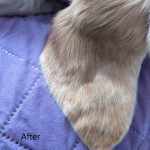

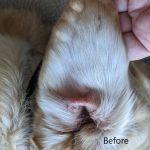
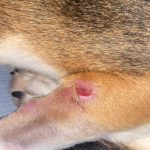


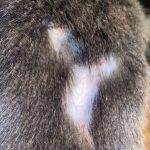
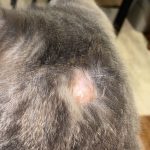
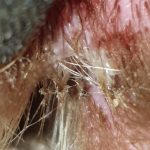
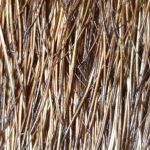
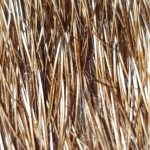
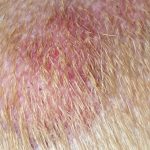
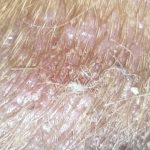
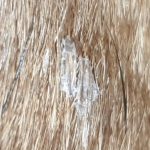
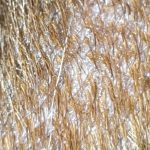
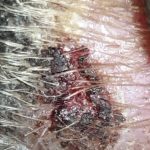
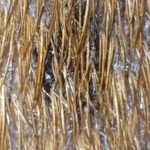
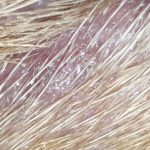
Hello,
I’m sorry to hear about your dog. I am happy to see your pet at my vet clinic in Maryland. It is the only way I can offer pertinent advice that is specific to each patient.
Without a biopsy it is impossible to know whether this is benign or not. Also in some cases the mass may be an incidental finding (no clinical relevance). We should always treat the patient and not make presumptive decisions, especially euthanasia.
I feel it to be morally and ethically dishonest to ever recommend euthanasia without a definitive diagnosis AND a suffering patient.
I hope this helps. I apologize for the delay.